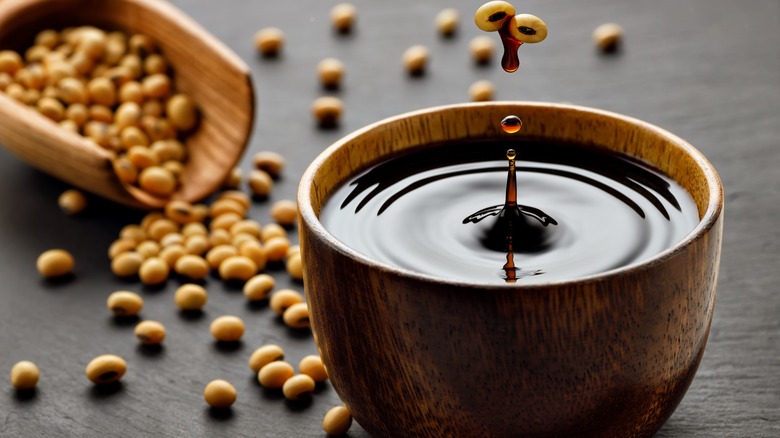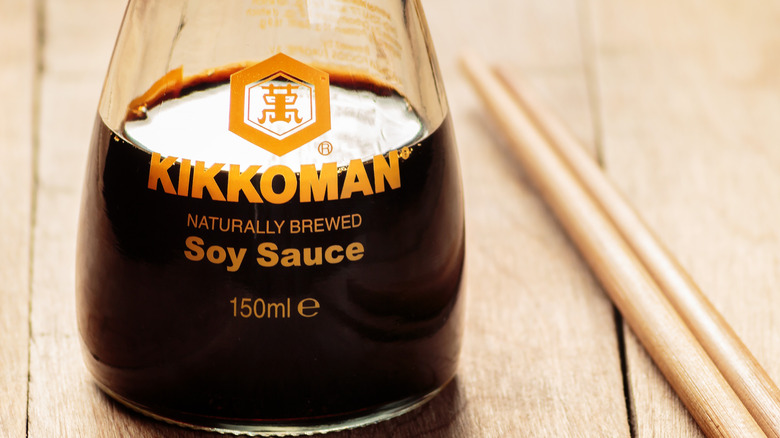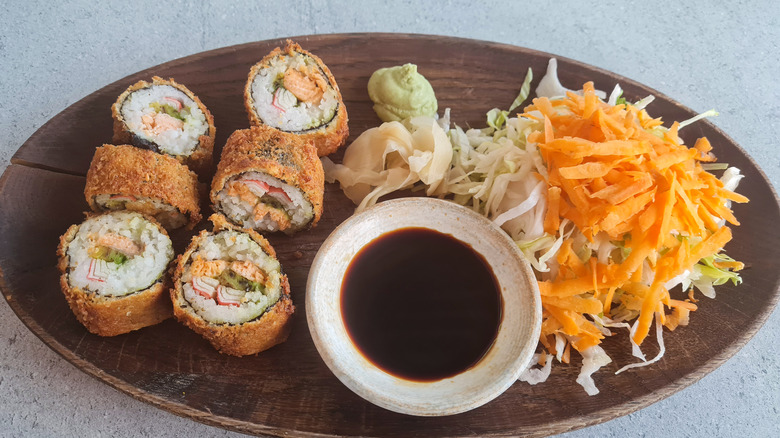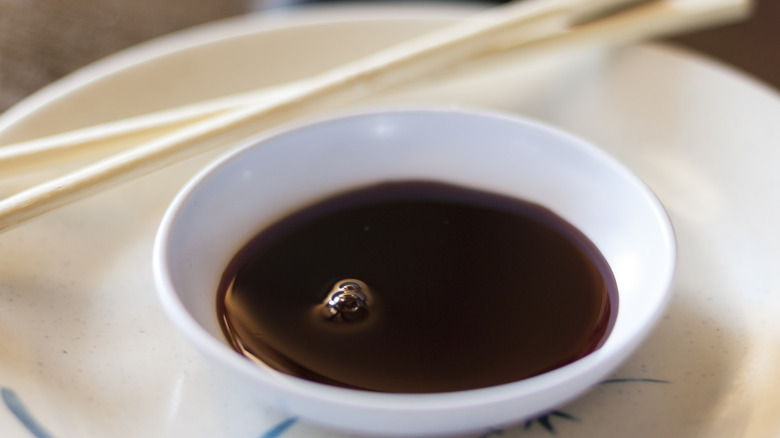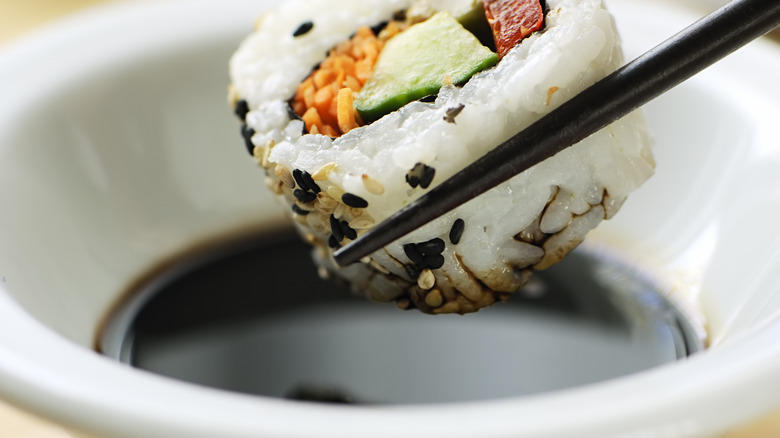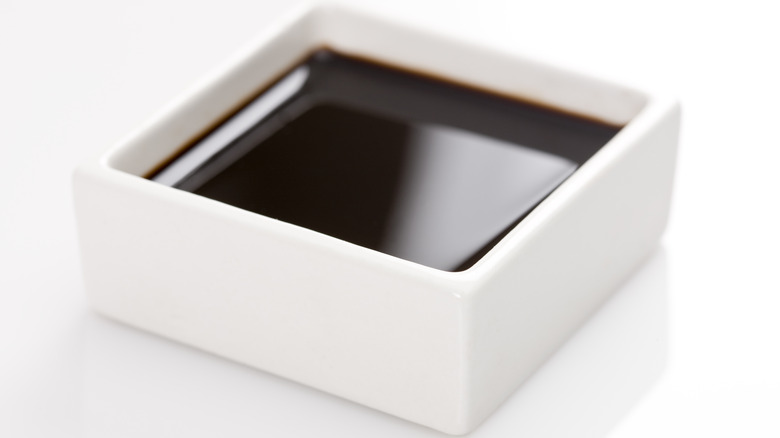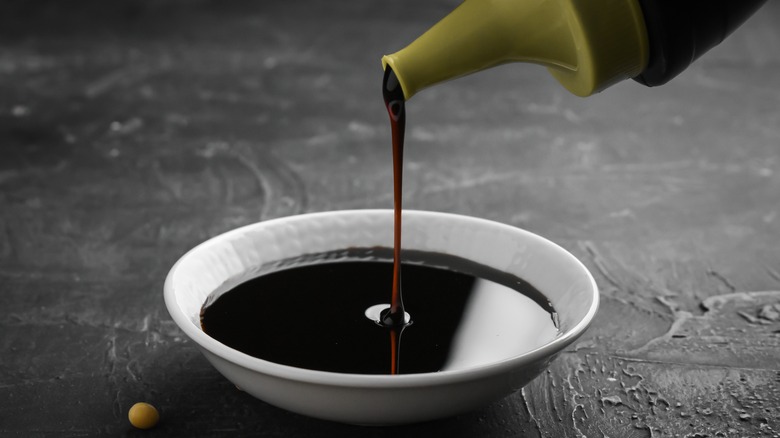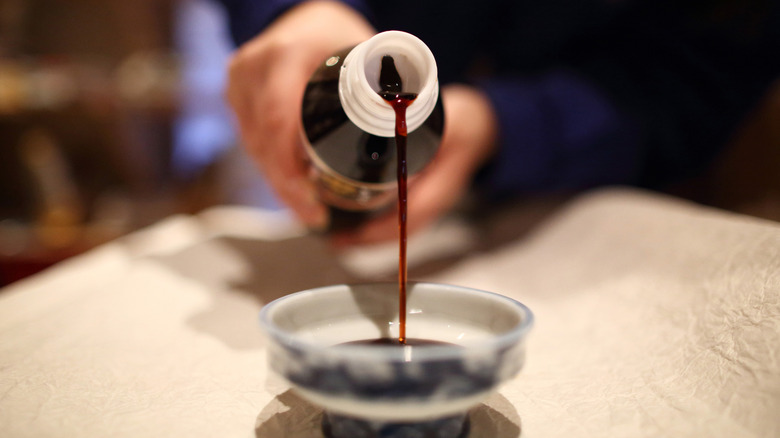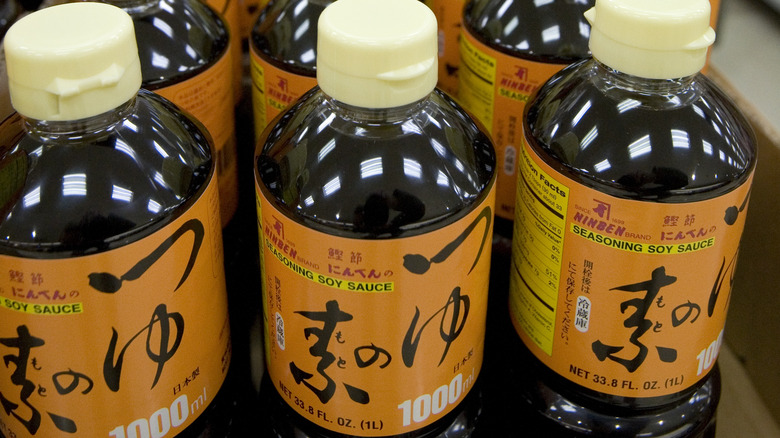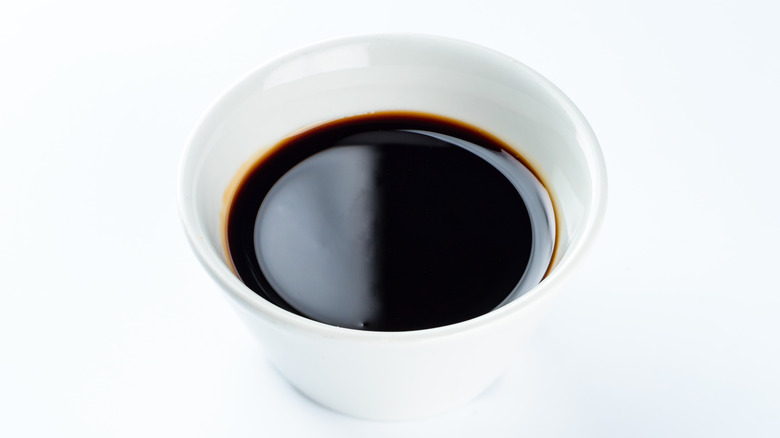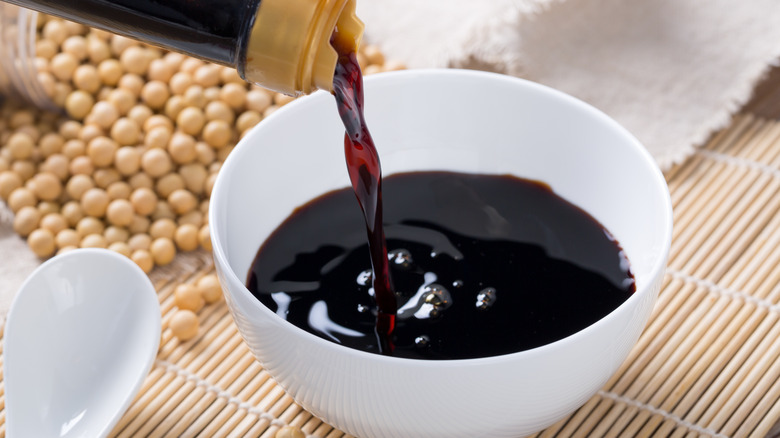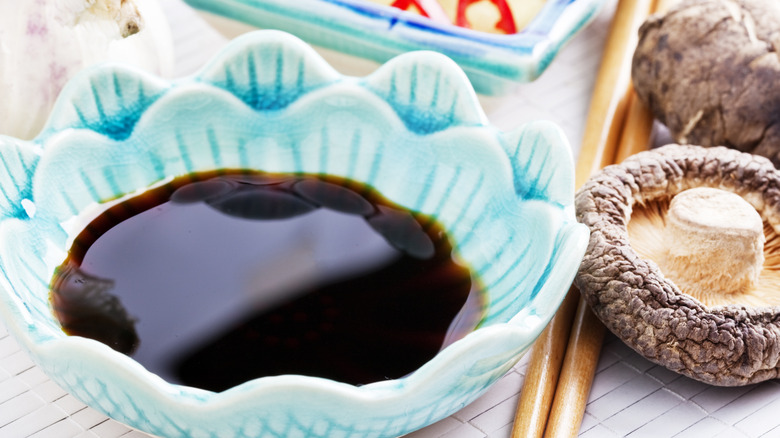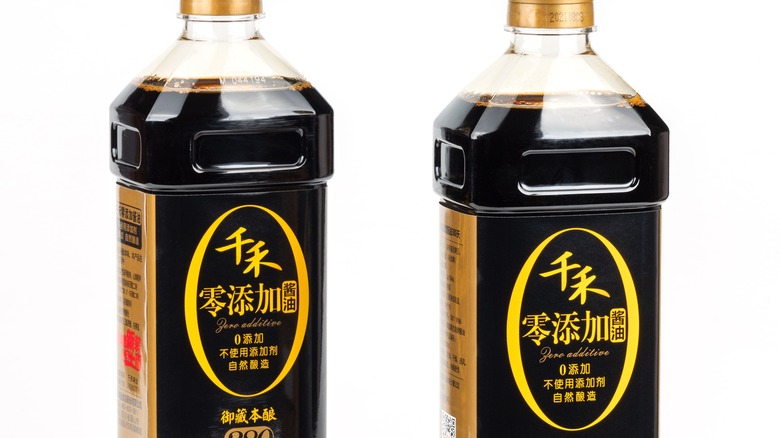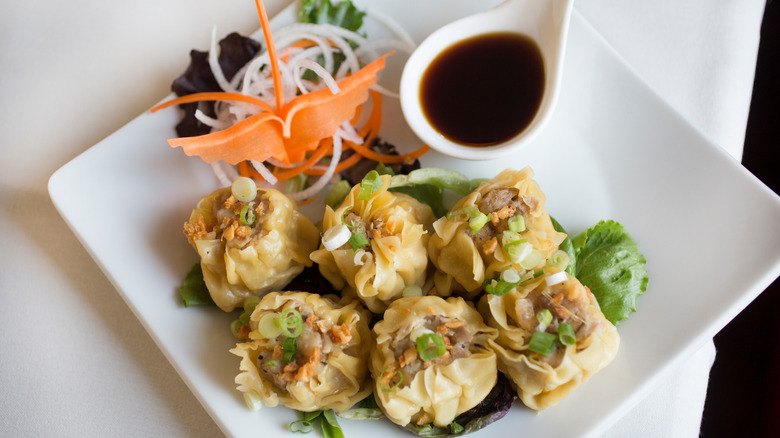13 Types Of Soy Sauce And How To Cook With Them
Soy sauce, also known as "Shoyu" in Japan, "Jiang you" in China, and "Ganjang" in Korea, is one of humanity's oldest condiments. The sauce dates back around 2,000 years to ancient China's western Han dynasty. At its inception, soy sauce was used as a preservative. Buddhists also adopted it to spice up their bland vegetarian diet, as salt was a luxury worth a king's ransom.
The soy sauce you know today has evolved remarkably from its predecessor. While originally the ingredients were fermented fish, salt, and soybeans, modern soy sauce mostly comprises wheat, soybeans, water, salt, and yeast. The process involves mixing the ingredients at different stages of production and aging the mixture until the desired condiment is achieved. The end products vary widely (colors, flavors, and textures) depending on the production process, ratio of wheat to soybeans, fermentation, mold used, and types of additives.
Its distinct umami flavor and appealing color have made soy sauce a popular spice in many kitchens. But there's just one problem: Which soy sauce is good when most recipes don't specify? Well, the next time you shop for soy sauce, you don't have to scout the whole aisle for which one to buy — because we're unraveling the mystery and giving you 13 types of soy sauce you can use for all kinds of dishes.
Dark Japanese soy sauce
Dark Japanese soy sauce, also known as "koikuchi shoyu," is the most common soy sauce used in Japanese cuisine. It's also the most readily available Japanese soy sauce at your local grocery stores. Although you might not be aware, Kikkoman Naturally Brewed Soy Sauce — we bet you have one in your pantry — is a Japanese dark soy sauce.
The dark soy sauce gets its deep reddish brown color from the long fermentation process that lasts from six months up to three years. The production process involves the same ratio of wheat to soybeans, unlike Chinese soy sauce, which uses a high ratio of soybeans to wheat. In the production process, soybeans are cleaned, steamed and mixed with roasted wheat (via the Journal of Agricultural and Food Chemistry). Koji mold is introduced into the mixture and stored at room temperature for three days. In the second stage, brine is added to the solid mixture (koji). This process can take anywhere from six to eight months, after which the resulting moromi is pressed, filtered, pasteurized and bottled for sale.
Dark Japanese soy sauce has little salt. It also has a strong aroma because of the wheat-to-soybeans ratio, making it thick with a round sweet taste. This soy sauce is all-purpose and can be used when cooking or applied to raw foods. Use it for marinades, stir-fries, dipping, topping, and sauces. You'll also find it perfect for recipes with long cooking times, like poultry or meat. Whenever Japanese recipes call for soy sauce, they imply dark soy sauce.
Light Japanese soy sauce
Light Japanese soy sauce is referred to as "usukuchi-shoyu" in Japan. It's reddish brown. Its lighter color is because of the fermentation process. The light soy sauce is made of the same ratio of wheat to soybeans as darker soy sauce, but the fermentation process is shorter. It doesn't age for the same period as dark Japanese soy sauce (per the Journal of Agricultural and Food Chemistry). Also, in the second fermentation stage, highly concentrated brine is added to the mixture to stop the fermentation process by hindering the growth of koji mold from the first fermentation stage.
The resulting moromi is saltier and milder in flavor than dark soy sauce. This soy sauce is also thin in consistency. Because of its high salt content, it gives the best result when used sparingly as a seasoning in place of salt. You may also use it to enhance the color of your cuisine without overpowering the colors of the different ingredients. Use light Japanese soy sauce when making soups or sauces.
White Japanese soy sauce
White Japanese soy sauce, also known as shiro-shoyu, is lighter in color and thinner than light Japanese soy sauce. Its faint golden brown color is because the production process uses more wheat than soybeans. Further, the fermentation process is tailored to ensure the color doesn't change to a deep reddish brown, typical of regular soy sauce.
While the other Japanese soy sauces are made from roasting wheat and steaming soybeans, white soy sauce takes the opposite direction. The soybeans are roasted while the wheat is steamed. Further, the fermentation process takes a shorter time, and the final product is not pasteurized, meaning this soy sauce has a short life span. White Japanese soy sauce is sweeter than dark soy sauce because of its high wheat content. Again, it's saltier than dark soy sauce, which makes it ideal for dishes where a pitch of the umami flavor goes a long way.
The white soy sauce production process lends the sauce a milder taste and color. When used in a recipe, it maintains the food's taste and color. White Japanese soy sauce is ideal for dressing, egg recipes, soups, pickles or rice crackers.
Japanese tamari
Tamari soy sauce has a strong umami flavor with a darker shade than the other Japanese soy sauces because soybean concentration is considerably high with little to no wheat. The sauce is also thicker with a mellow taste and mild aroma, given the low wheat content, which is the reason it's the perfect gluten-free soy sauce. A point of caution: It's best to check the labels for ingredients used before buying tamari soy sauce if you are gluten intolerant.
Japanese Tamari is a by-product of pressing miso. According to the Journal of Food Science, miso is produced through a two-step fermentation process. The first step involves making koji by introducing "Aspergillus oryzae" to steamed rice, which, in the second step, is added to soybean mash and salt and fermented for two years.
Japanese Tamari is good for dipping, grilling, final seasoning, braising, and glazing. You can also use it instead of regular soy sauce in your cooking if you are gluten intolerant, but it will impart a different flavor from the taste of all-purpose Japanese soy sauce.
Double-fermented Japanese soy sauce
"Saishikomi Shoyu" is a re-fermented soy sauce, which is why it has a darker color, a richer umami taste, and stronger aroma than other Japanese soy sauces.
Double-fermented soy sauce is made the same way as dark Japanese soy sauce — the ratio of wheat to soybeans is the same. In the first processing stage, koji mold is introduced into the solid mixture and fermented for three days. In the second stage of aging, soy sauce is added to the solid mixture instead of brine, boosting enzymatic action for a deeper savory flavor and aroma.
Given the fermentation process, the end product is of premium quality, which implies it's more expensive than the other soy sauces. For that reason, double-fermented soy sauce is often used at the table for dipping raw fish, tofu, sushi or sashimi. You can also use it as a finishing sauce — a little goes a long way.
Dark Chinese soy sauce
Despite the many varieties of Chinese soy sauce, they are divided into two distinctive categories: dark and light. Unlike Japanese soy sauce, Chinese soy sauce uses a higher ratio of soybeans to wheat, typically 80 to 20 or 70 to 30 (via the Journal of Agricultural and Food Chemistry). The publication further reveals that the fermentation process for Japanese and Chinese soy sauce follows the same steps, although the production conditions may vary. The aging process takes one to six months, and instead of roasted wheat, it uses wheat flour.
Dark Chinese soy sauce is also known as high-salt liquid-state fermentation soy sauce (HLFSS). It has a dark brown color that you might confuse for black. It's thicker than light Chinese soy sauce and sweeter as sugar or molasses is added.
Dark Chinese soy sauce is ideal for stews that take a long time to cook as it gives a pleasant caramel-like hue to the dish. This soy sauce has a cooked potato-like and caramel-like taste that considerably enhances the flavor of your food. But, given its dark color and strong taste, use it sparingly for the best result.
Light Chinese soy sauce
Light Chinese soy sauce is also referred to as low-salt solid-state fermentation soy sauce (LSFSS). Wheat bran and defatted soybeans comprise LSFSS, meaning it's low quality compared to HLFSS. Additionally, it takes a shorter aging time than dark Chinese soy sauce. LSFSS is the most readily available Chinese soy sauce since its cost of production is low. Hence, it's cheap. This soy sauce has a sour, burnt-like taste.
Although of lower quality than HSFSS, there are premium light Chinese soy sauces produced from the first press of soybeans or double fermentation, where a brewed light soy sauce is used instead of brine in the second fermentation stage.
Compared to dark Chinese soy sauce, light soy sauce has a milder taste, thinner consistency and lighter color. Thus, it's good for dipping, seasoning, or dressing. You can also add it to soups. Whenever a Chinese recipe requires soy sauce, it implies light Chinese soy sauce. And since light Chinese soy sauce is the default in Chinese cuisine — just like dark Japanese soy sauce in Japanese dishes — you can substitute the two for recipes that don't specify the type of soy sauce.
Korean soy sauce
There are three main Korean soy sauces: "guk ganjang," "yangjo ganjang" and "jin ganjang." The three soy sauces have different production processes. Guk ganjang is the traditional Korean soy sauce. It can be traced back to AD 7th century. This soy sauce is made from fermented soybeans (meju), water and salt. The mixture is then filtered and aged some more for the final product. Guk ganjang has a deep umami flavor. It's a bit sweet and salty. This soy sauce is all-purpose and an excellent addition to stews, soups, stir-fries, marinades, and dipping (per MDPI).
Yangjo ganjang is a version of dark Japanese soy sauce. It's made from wheat, soybeans, water, and salt. It goes through the same production process as the Japanese dark soy sauce. Yangjo ganjang can be used instead of guk ganjang as it's also an all-purpose soy sauce. Jin ganjang is produced through chemical hydrolysis. Instead of natural fermentation, hydrochloric acid breaks soybeans into amino acids and wheat into glucose. The mixture is heated at high temperatures for several hours. It's then neutralized because of the high acidity, and finally filtered and bottled for sale — chemical hydrolysis speeds up the production process.
Indonesian sweet soy sauce
Indonesian sweet soy sauce is also known as "kecap manis." As the name suggests, it's native to Indonesia. The production process is similar to Japanese and Chinese soy sauces, except for the sweetener additive. According to Springer Link, kecap manis is made from fermented black soybeans and aged in brine for around four months. The mixture (moromi) is filtered, and the resulting liquid is sweetened with coconut sugar and spices.
Other sweeteners used in kecap manis besides coconut sugar include jaggery, palm sugar and caramelized sugar. Further, a wide range of spices can be added for a unique taste: cinnamon, black pepper, cloves, star anise and coriander.
Kecap manis is incredibly sweet with a savory flavor, thick in consistency, and darker in color. It's the star behind the famous Indonesian fried rice and stir-fried noodles. This soy sauce adds depth of flavor to stews, stir-fries, marinades and grilled recipes.
Taiwanese soy sauce
The traditional Taiwan soy sauce is made from black soybeans. The fermentation process starts with cleaning the soybeans before steaming them. From there, koji is added to the beans and left to sit at room temperature for some days so molds can form and break the soybeans into amino acids. The molds are washed off in the next step before water and salt are added at different ratios for the desired flavor.
Next, the mixture is poured into clay pots and left outside in the sun for not less than four months. The temperatures must always be maintained for the desired flavors, colors, and aromas. If it gets too hot, fans cool off the temps; when too cold, heaters are turned on. The key is ensuring the optimum temperature for the perfect Taiwanese soy sauce (per Taiwan Today).
It doesn't end there. The rich umami flavor can only be achieved by cooking the raw soybeans over a wood-fired stove — but you've got to double-down on this method and cook them twice on the stove. While in the first step, the soybeans are only heated, the second step involves adding flavors and sugar. Given the elaborate production process, Taiwanese soy sauce is mostly used as a dipping sauce — it perfectly compliments pork belly and dumplings.
Seasoned soy sauce
While the regular soy sauce does a great job imparting umami flavor to dishes, you can amp the flavor of your meal using seasoned soy sauces, which as you'll find out, come in different flavors: smoky, mushroom, and shrimp.
The aromas are infused into the soy sauce after the final stage of regular soy sauce production. Cherry wood smoke is used to infuse a smoky aroma in the case of smoky flavored soy sauce (via Plant Based Matters). It blends well with the umami flavor giving an additional savory profile. Try using it with baked or grilled tofu, pasta dishes, or grilled veggies.
Most mushroom flavored soy sauces in the market are brewed with dried straw mushrooms. However, you can occasionally come across some infused with dried Chinese black mushrooms. The mushroom soy sauce can substitute the regular all purpose dark soy sauce in cooking or raw foods. Shrimp flavored soy sauce is fermented with brine infused with dried prawns. It's perfect for seafood. Although, you'll rarely find it at your local food market.
Non-fermented soy sauce
Non-fermented soy sauce is made through the process of acid hydrolysis. Concentrated hydrochloric acid is used instead of koji mold or starter to break down wheat and soybeans. The mixture is heated at high temperatures for 20 to 35 hours. Next, the acidity is neutralized using sodium carbonate and sodium hydroxide. And finally, the final mixture is left for impurities to settle and then filtered for bottling (via the Journal of Agricultural and Food Chemistry).
Since this soy sauce does not undergo the natural fermentation process, where enzymatic reactions produce the umami flavor and dark brown/reddish brown color typical of traditional soy sauce, additives give it the taste and color of soy sauce. Usually, caramel, cornstarch, water, salt and other flavors, colors, and aromas are added in different ratios. In some cases, traditionally brewed soy sauce is added to give it a touch of soy sauce flavor and aroma. Non-fermented soy sauce can be used in pasta, meat, poultry, and rice. It also supplements raw foods incredibly well.
While traditional soy sauce takes months to mature, chemically hydrolyzed soy sauce is ready in a matter of days. It's cheaper to produce and also sold at cheaper prices. The downside? It doesn't taste like the traditionally fermented soy sauce. Thus, when buying soy sauce, read the label for the ingredients. Traditionally brewed soy sauce should have water, salt, wheat and soybeans as the main ingredient.
Thick soy sauce
From the name, this type of soy sauce is thicker than regular soy sauce. It's also sweeter than its counterparts. It's sometimes referred to as soy paste or jam — although you may find it with syrup consistency. The difference in taste and consistency is because of the ratio of wheat to soybeans during fermentation. Thick soy sauce has a high wheat concentration. Additionally, sugar is added to the mixture, making it more dense. Sometimes, a starch thickener is mixed in for a thicker final product.
Thick soy sauce adds flavor to fried rice dishes, stir-fries, and stews. You can also use it as a dipping sauce, and since it's thick, it simply coats the food dipped in it without altering the flavor of the food. Try it next time with dumplings. Even better, elevate your bowl of steamed veggies with a dash of thick soy sauce.
Ginger thick soy sauce is a variety of thick soy sauce — you can't go wrong with it if ginger is your go-to spice!

